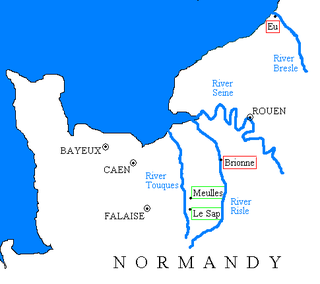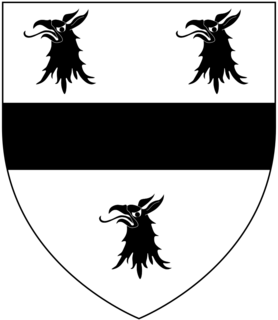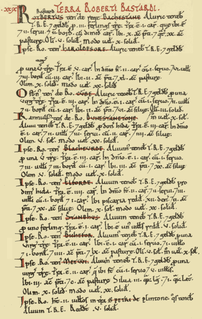Related Research Articles

Cruwys Morchard is an ecclesiastical and civil parish in the Mid Devon district of the county of Devon in England. It is located about four to five miles west of Tiverton along the road to Witheridge. The parish covers about 5,765 acres (23.33 km2) of land, and comprises a number of scattered houses and farms, and three small hamlets, Pennymoor, Way Village and Nomansland. The church and the manor house are in the centre of the parish. The population at the time of the 2000 census was 461. The parish takes its name from the Cruwys family who have been Lords of the Manor here since the reign of King John (1199–1216).

Canonsleigh Abbey was an Augustinian priory in the parish of Burlescombe, Devon.

Baldwin FitzGilbert was a Norman magnate and one of the 52 Devon Domesday Book tenants-in-chief of King William the Conqueror, of whom he held the largest fiefdom in Devon, comprising 176 holdings or manors. He was feudal baron of Okehampton, seated at Okehampton Castle in Devon.

Bucks Mills is a small village within the parish of Woolfardisworthy on the north coast of Devon, England. It was anciently the mill of the manor of Bucks, anciently Bokish, Buckish, Bochewis, etc., listed in the Domesday Book of 1086 as Bochewis. The village is within the North Devon Coast Area of Outstanding Natural Beauty and on the South West Coast Path.

Huish is a small village, civil parish and former manor in the Torridge district of Devon, England. The eastern boundary of the parish is formed by the River Torridge and the western by the Rivers Mere and Little Mere, and it is surrounded, clockwise from the north, by the parishes of Merton, Dolton, Meeth and Petrockstowe. In 2001 the population of the parish was 49, down from 76 in 1901.

Collaton St Mary is a village, parish and former manor in Devon, England, situated about 2 miles (3 km) west of the town of Paignton. The village is bisected by the A385 Paignton to Totnes road. The parish is now administered within the unitary authority of Torbay, Devon.
The feudal barony of Gloucester or Honour of Gloucester was one of the largest of the mediaeval English feudal baronies in 1166, comprising 279 knight's fees, or manors. The constituent landholdings were spread over many counties. The location of the caput at Gloucester is not certain as Gloucester Castle appears to have been a royal castle, but it is known that the baronial court was held at Bristol in Gloucestershire.
Walter I de Claville was an Anglo-Norman magnate and one of the 52 Devon Domesday Book tenants-in-chief of King William the Conqueror. He also held lands in Dorset. His Devonshire estates later formed part of the feudal barony of Gloucester.

The Domesday Book of 1086 lists in the following order the tenants-in-chief in Devonshire of King William the Conqueror:
William Cheever was one of the 52 Devon Domesday Book tenants-in-chief of King William the Conqueror. He held 46 landholdings in Devon. His lands later formed, the feudal barony of Bradninch, Devon. His brother was Ralph de Pomeroy, feudal baron of Berry Pomeroy, Devon, with whom several of his holdings had been divided into two parts, one for each brother. His sister was Beatrix, who held from him the manor of Southleigh.
Ralph de Pomeroy was one of the 52 Devon Domesday Book tenants-in-chief of King William the Conqueror and was the first feudal baron of Berry Pomeroy in Devon. He held 58 landholdings in Devon.

Stafford is an historic manor in the parish of Dolton in Devon, England. The present manor house known as Stafford Barton is a grade II* listed building. A house of some form has existed on the manor probably since the Norman Conquest in the 11th century. Surviving walls can be dated to the 16th century. Many additions and renovations have taken place in the intervening years, and in the early 20th century Charles Luxmoore made many alterations and extensions and imported several major architectural features from ancient local mansions undergoing demolition so that "it has become somewhat difficult to discern its original form". In the nineteenth century the estate was very substantial, with 400 acres of associated farmland and a large staff, and by 1956, at the end of the Luxmoore tenure, it had grown to 1,460 acres with 7 farms, several cottages and smallholdings.
Gotshelm was an Anglo-Norman magnate and one of the 52 Devon Domesday Book tenants-in-chief of King William the Conqueror and was also a Cornwall Domesday Book tenant-in-chief. He is listed in the Domesday Book of 1086 as holding 28 estates or manors in Devon from the king. His brother was Walter de Claville, also a Devon Domesday Book tenant-in-chief, who held 32 estates or manors in Devon from the king.

Washfield is a village, parish and former manor in Devon, England, situated about 2 miles north-west of Tiverton. The parish church is dedicated to St Mary the Virgin. It was within the jurisdiction of the historic West Budleigh Hundred.

Widworthy is a village, parish and former manor in Devon, England. The village is 3 1/2 miles east of Honiton and the parish is surrounded clockwise from the north by the parishes of Stockland, Dalwood, Shute, Colyton, Northleigh, and Offwell. The parish church is dedicated to St Cuthbert. Near the church is Widworthy Barton, the former manor house, which is largely unaltered from its early 17th century form. Widworthy Court is a mansion within the parish built in 1830 by Sir Edward Marwood Elton to the design of G.S. Repton.

Kenedon is an historic manor situated in the parish of Sherford in Devon.

Robert Bastard (fl.1086) was a Norman warrior who assisted in the 1066 Norman Conquest of England under King William the Conqueror. He was subsequently rewarded with landholdings in Devonshire and is one of the Devon Domesday Book tenants-in-chief of that monarch, with a holding of 10 manors or estates held in chief, 8 of which he held in demesne, i.e. under his own management without tenants. He had at least one further holding as a mesne tenant, at Goosewell, Plymstock parish, Plympton hundred, held from William of Poilley, a Norman tenant-in-chief from Poilley in Normandy, most of whose 21 landholdings were later granted by King Henry I (1100–1135) to his trusted supporter Richard de Redvers, feudal baron of Plympton in Devon.

Hareston is an historic estate in the parish of Brixton, about three miles from Plymouth in Devon. The mansion house built during the reign of King Henry VII (1485-1509) burned down partially in an accidental fire at the beginning of the 18th century, and in 1822 the surviving part, the Hall and Chapel, was being used as a farmhouse. It was described by Candida Lycett Green in her 1991 book The Perfect English Country House as: "The most forgotten Manor House Farm In England, untouched for hundreds of years, sits safely, impossible to find, down miles of private sunken lanes which in the spring brim with Campion, Bluebells, Purple Orchids, Primroses, Violets, Speedwell and Stitchwort. Wooded hills rise behind this, the quintessence of an ancient English Manor House".
Erchenbald or Archembald was a mesne lord listed in the Domesday Book of 1086 as a tenant of nine manors in Devon and Cornwall, England. He is believed to be the first English ancestor of the prominent Fleming family.
Nicholas the Bowman, also known as Nicholas de la Pole, was a servant of King William the Conqueror (1066-1087) and was one of that king's Devon Domesday Book tenants-in-chief. He was also a tenant-in-chief in Warwickshire and at some time between 1095 and 1100 he exchanged his manor of Ailstone in Warwickshire for the manor of Plymtree in Devon, held by St Peter's Abbey, Gloucester.
References
- ↑ Thorn, Caroline & Frank, (eds.) Domesday Book, (Morris, John, gen.ed.) Vol. 9, Devon, Parts 1 & 2, Phillimore Press, Chichester, 1985, 40,1-7
- ↑ Thorn & Thorn, part 2 (notes), chap.40
- ↑ Thorn & Thorn, part 2 (notes), chap.15, 12-13
- ↑ Thorn & Thorn, part 1, 15,12-15
- ↑ Thorn & Thorn, part 2 (notes), chap.40,1